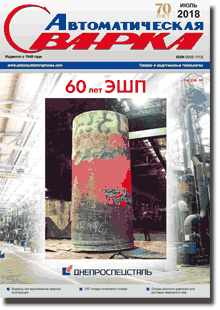| 2018 №07 (02) |
DOI of Article 10.15407/as2018.07.03 |
2018 №07 (04) |

Avtomaticheskaya Svarka (Automatic Welding), # 7, 2018, pp. 18-23
To the issue of modeling the structure of transverse magnetic field in the area of welding pool
A.D. Razmyshlyaev1, P.A. Vydmysh2, M.V. Ahieieva3
1State Higher Eductation Instittue Pryazovskyi State Technical University 7, Universitetskaya Str., 87500, Mariupil, Ukraine. Е-mail: razmyshljаеу@gmail.com
2OJSC «Metinvest-Promservis», 113-а Nikopol ave., 87500, Mariupil, Ukraine, Е-mail: pstukmu@gmail.com
3Donbass State Machine Building Academy, 72 Akademicheskaya Str., 84313, Kramatorsk, Ukraine. Е-mail: maryna_ah@ukr.net
It was established experimentally that a normal component of induction along the side surfaces of rods of the device for input of transverse magnetic field is distributed almost uniformly (has the same values). A slight increase in the values of this induction component is observed only in the zones near the ends of the rods and near the coils, placed on these rods. To study the distribution of induction of a transverse magnetic field in the welding pool area (near the surface of the base metal) it was proposed to use the well-known assumption that there is an analogy between the structure of magnetostatic and electrostatic fields. On this basis, a procedure was proposed which allows calculating the distribution of transverse and longitudinal components of induction of the magnetic field generated by the device for input of the transverse magnetic field near the surface of the welded plate of non-magnetic materials. In this case, the known electrostatic equations are used. It was assumed in the calculations that the charges of electrostatic field on the side surfaces and ends of the rods of the device for input of the transverse magnetic field are uniformly distributed. It is shown that the proposed method provides a satisfactory convergence of calculated and experimental data. 8 Ref., 6 Fig.
Keywords: transverse magnetic field, induction, Coulomb’s law, electrostatic field intensity
Received: 29.05.2018
Published: 19.06.2018
References
- Skipersky, N.A., Rybachuk, A.M. (2000) Weld formation by transverse magnetic field in welding of nonmagnetic materials. Proizvodstvo, 7, 53-55 [in Russian].
- Iofinov, P.A., Ibragimov, V.S., Dmitrienko, A.K. et al. (1991) Influence of external electromagnetic field on melting rate of electrode wire in submerged-arc welding. Ibid., 1, 34-35 [in Russian].
- Razmyshlyaev, A.D., Mironova, M.V., Kuzmenko, K.G. (2011) Efficiency of melting of electrode wire in submerged-arc surfacing with influence of transverse magnetic field. The Paton Welding J., 5, 39-42.
- Ryzhov, R.N., Kuznetsov, V.D. (2006) External electromagnetic effects in arc in processes of arc welding and surfacing (Review). , 10, 29-35.
- Andreeva, E.G., Shamets, S.P., Kolmogorov, D.V. (2005) Calculation of stationary magnetic fields and characteristics of electric devices using program package ANSYS. Electronic Sci. J. Oil and Gas Business, 1. http://ogbus.ru/authors/Andreeva/Andreeva_1.pdf.
- Bessonov, L.A. (2003) Theoretical fundamentals of electrical engineering. Electromagnetic field. Moscow, Gardariki [in Russian].
- Tozoni, O.V. (1975) Method of secondary sources in electrical engineering. Moscow, Energiya [in Russian].
- Razmyshlyaev, A.D., Mironova, M.V., Yarmonov, S.V. et al. (2013) Structure of transverse magnetic field generated by input devices for arc welding process. Visnyk Pryazov. DTU: Transact. Mariupol, PDTU, 135-141 [in Russian].
